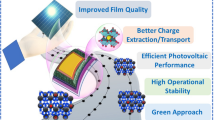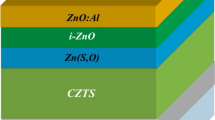Abstract
40 alternate a-Si/SiN x multilayer are incorporated as an absorber layer in a p–i–n solar cell. The device is fabricated using hot-wire chemical vapor deposition (HWCVD) technique. The structure of the multilayer film is examined by high resolution transmission electron microscopy (HR-TEM) which shows distinct formation of alternate a-Si and SiN x layers. The a-Si and SiN x layers have thickness of ~3.5 and 4 nm, respectively. The photoluminescence (PL) of multilayer film shows bandgap energy of ~2.52 eV, is larger than that of the c-Si and a-Si. Dark and illuminated current–voltage (I–V) characterization of the ML films shows that these ML are photosensitive. In the present work, it is seen that the p–i–n structure with i-layer as ML quantum well (QW) structures show photovoltaic effect with relatively high open-circuit voltage (V OC). The increment of bandgap energy in PL and high V OC of the device is attributed to the quantum confinement effect (QCE).



Similar content being viewed by others

References
Abeles B, Tiedje T (1983) Amorphous semiconductor superlattices. Phys Rev Lett 51:2003–2006
Green MA (2000) Potential for low dimensional structures in photovoltaics. Mater Sci Eng B74:118–124
Hazama Y, Yamada K, Miyazaki S, Hirose M (1989) a-Si3N4:H/a-Si:H superlattices produced by plasma enhanced nitridation of a-Si:H. J Non Cryst Solids 114:777–779
Jiang CW, Green MA (2006) Silicon quantum dot supperlattices: modeling of energy bands, densities of states, and mobilities for silicon tandem solar cell applications. J Appl Phys 99:114902–114908
Matsumura H, Umemoto H, Masuda A (2004) Cat-CVD (hot-wire CVD): how different from PECVD in preparing amorphous silicon. J Non Cryst Solids 338–340:19–26
Murayama K, Toyama T, Miyazaki S, Hirose M (1997) Fundamental absorption edge spectrum of ultrathin a-Si:H film in a-Si:H/a-Si3N4:H multilayer obtained from luminescence excitation spectrum. Solid State Commun 104(2):119–123
Panchal AK, Solanki CS (2009a) Fabrication of silicon quantum dots in SiN x multilayer using hot-wire CVD. J Cryst Growth 311:2659–2663
Panchal AK, Solanki CS (2009b) Post deposition annealing temperature effect on silicon quantum dots embedded in silicon nitride dielectric multilayer prepared by hot-wire chemical vapor deposition. Thin Solid Films 517:3488–3491
Rölver R, Berghoff B, Bätzner DL, Spangenberg B, Kurz H (2008a) Lateral Si/SiO2 quantum well solar cells. Appl Phys Lett 92:212108
Rölver R, Berghoff B, Bätzner DL, Spangenberg B, Kurz H, Schmidt M, Stegemann B (2008b) Si/SiO2 multiple quantum wells for all silicon tandem cells: conductivity and photocurrent measurements. Thin Solid Films 516:6763–6766
Schropp REI, van der Werf CHM, Verlaan V, Rath JK, Li H (2009) Ultrafast deposition of silicon nitride and semiconductor silicon thin films by hot wire chemical vapor deposition. Thin Solid Films 517:3039–3042
Stegemann B, Schoepke A, Schmidt M (2008) Structure and photoelectrical properties of SiO2/Si/SiO2 single quantum wells prepared under ultrahigh vacuum conditions. J Non Cryst Solids 354:2100–2104
Sze SM (1981) Physics of semiconductor devices, 2nd edn, chap 1. Wiley, New York, pp 30
Sze SM, Ng KK (2007) Physics of semiconductor devices, 3rd edn. Wiley-Interscience, Wiley, New York
Umemoto H, Nozaki Y, Kitazoe M, Horii K, Ohara K, Morita D, Uchida K, Ishibashi Y, Komoda M, Kamesaki K, Izumi A, Masuda A, Matsumura H (2002) Effects of atomic hydrogen in gas phase on a-Si:H and poly-Si growth by catalytic CVD. J Non Cryst Solids 299–302:9–13
van Veen MK, Schropp REI (2003) Understanding shunting behavior in hot-wire-deposited amorphous silicon solar cells. Appl Phys Lett 82(2):287–289
van Veen MK, van Veenendaal PATT, van der Werf CHM, Rath JK, Schropp REI (2002) a-Si:H/poly-Si tandem cells deposited by hot-wire CVD. J Non Cryst Solids 299–302:1194–1197
van Veen MK, van der Werf VHM, Rath JK, Schropp REI (2003) Incorporation of amorphous and microcrystalline silicon in n–i–p solar cells. Thin Solid Films 430:216–219
Acknowledgments
Authors would like to thank Dr. P. K. Narwankar, Applied Materials USA for the TEM analysis of films. Discussions for characterizations of films with Prof. S. S. Major, IIT Bombay are also overwhelmed by the authors.
Author information
Authors and Affiliations
Corresponding author
Rights and permissions
About this article
Cite this article
Panchal, A.K., Rai, D.K., Mathew, M. et al. a-Si/SiN x multilayered light absorber for solar cell. J Nanopart Res 13, 2469–2473 (2011). https://doi.org/10.1007/s11051-010-0139-4
Received:
Accepted:
Published:
Issue Date:
DOI: https://doi.org/10.1007/s11051-010-0139-4



